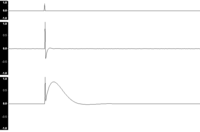Impulse response

Imagine you're playing with your favorite toy car on a bumpy road. When you push the car forwards and then suddenly stop pushing it, it will keep rolling along for a little bit before coming to a full stop. The way the car slows down and stops is called its impulse response.
Now, instead of a toy car, let's imagine we have a speaker playing a sound. The speaker produces sound waves that travel through the air and bounce off walls, floors, and other objects in the room. When we turn off the speaker, the sound doesn't instantly disappear - it bounces around the room for a little bit before fading away completely. This is also an impulse response, just like how the toy car slows down and stops rolling.
In audio and engineering, impulse response refers to the way a system or device responds to a short burst of sound (an impulse). It tells us how sound waves behave in a space or through a device, based on factors like the size of the room, the materials of the walls and floors, and the design of the speaker, microphone, or other equipment.
By measuring and analyzing impulse responses, engineers can create models of how sound will behave in different settings. This is useful for designing speakers, building concert halls, or even creating digital audio effects. So next time you play with your toy car or hear music, remember that everything has an impulse response!
Now, instead of a toy car, let's imagine we have a speaker playing a sound. The speaker produces sound waves that travel through the air and bounce off walls, floors, and other objects in the room. When we turn off the speaker, the sound doesn't instantly disappear - it bounces around the room for a little bit before fading away completely. This is also an impulse response, just like how the toy car slows down and stops rolling.
In audio and engineering, impulse response refers to the way a system or device responds to a short burst of sound (an impulse). It tells us how sound waves behave in a space or through a device, based on factors like the size of the room, the materials of the walls and floors, and the design of the speaker, microphone, or other equipment.
By measuring and analyzing impulse responses, engineers can create models of how sound will behave in different settings. This is useful for designing speakers, building concert halls, or even creating digital audio effects. So next time you play with your toy car or hear music, remember that everything has an impulse response!
Related topics others have asked about:
